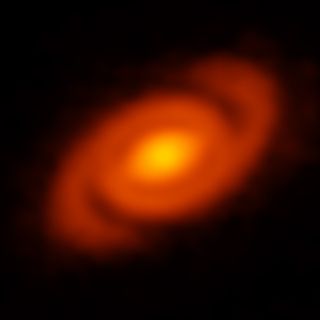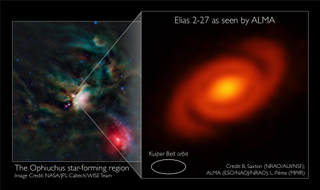Surprising Spiral Structure Found Around Young Star

For the first time, spiral arms much like those of the Milky Way galaxy have been found embracing a young star.
This finding may shed light on the mystery of how planets can form far away from their parent stars, the researchers behind the new study said.
When new stars form, the clouds of gas and dust around them collapse to form disks. Previous research suggested that planets originate within these "protoplanetary disks" as gravity pulls clumps of matter together into larger masses. In this case, though, researchers have spotted unusual spiral arms forming in the debris. [Birth of Planets! Formation of Alien Worlds Photographed for 1st Time]
Until now, astronomers usually detected spiral arms around stars only during the later stages of protoplanetary disks, such as when planets had already formed, and in hazy disks that were difficult to understand the structure of.
This new work is the first time researchers have detected such spiral arms around a very young star, caused by pile-ups of material researchers call density waves.
"These results are the first detection of spiral density waves in the reservoir of gas and dust that surrounds a newborn star," study lead author Laura Pérez, an astronomer at the Max Planck Institute for Radio Astronomy in Bonn, Germany, told Space.com. "Density waves are what cause the spiral arms observed in spiral galaxies, and it is remarkable that we observe the same phenomena but in physical scales related to planet formation, [which are] much, much smaller than galaxy scales."
To understand how spiral arms might form in protoplanetary disks, imagine traffic jams occurring within these disks, with faster-moving chunks of matter caught behind slower-moving material. Prior work suggested that such congestion leads to alternating regions of greater and lesser density, the so-called "density waves," akin to how water can bunch up and spread apart to form ripples on a pond. Since protoplanetary disks spin, the previous research suggested that those waves of density curve, taking on the shape of spiral arms. Researchers think similar activity on a larger scale created the Milky Way's spiral arms.
Get the Space.com Newsletter
Breaking space news, the latest updates on rocket launches, skywatching events and more!
This young star, named Elias 2-27, is located about 450 light-years from Earth, in the constellation Ophiuchus. The star is at least 1 million years old and about half the mass of the sun, and it possesses an unusually massive protoplanetary disk, up to about one-seventh the sun's mass, the astronomers said.

Using the Atacama Large Millimeter/submillimeter Array (ALMA), an enormous radio telescope in northern Chile, the researchers detected a flattened disk of dust around Elias 2-27 that reaches out to what would be about the orbit of Neptune in the solar system. Beyond that point, in a region analogous to the solar system's Kuiper Belt, the scientists found a narrow band with significantly less dust, which they said may be evidence of a planet in the process of forming. Emerging from the outer edge of this band are two spiral arms that extend more than 6.2 billion miles (10 billion kilometers) away from their host star.
That configuration paints an unusual picture, Pérez said: The spiral arms may be concentrating material that goes on to form planets far from the star. That the spiral arms seen around Elias 2-27 are quite far from their star provides evidence "for the first time of a different process than the standard picture of planet formation," Pérez said.
"The standard theory of planet formation is called 'core accretion,' where a planet core grows out of smaller particles and planetesimals," Pérez said. "Once the core is large enough, it quickly accretes gas from the disk and forms a planet with an atmosphere — think of Jupiter, with its massive inner core and then its massive atmosphere. However, this standard picture fails at large distances from the star. There are not enough dust particles and gas for core accretion to be proceed."
Previous research suggested that instabilities within protoplanetary disks could produce planets far from stars, "at the locations where core accretion fails," Pérez said, but researchers were uncertain about the mechanisms behind such planets' formation. "Our detection of spiral density waves in Elias 2-27 is the first time we have any evidence of a different process than core accretion, and these data may help explain the puzzling observations of extrasolar planets at similar faraway locations."
Future research with ALMA will analyze Elias 2-27's protoplanetary disks and similar formations, which may help shed light on the origin of these spiral arms and the role they might play in planet formation, Pérez said.
The scientists detailed their findings online today (Sept. 29) in the journal Science.
Follow Charles Q. Choi on Twitter @cqchoi. Follow us @Spacedotcom, Facebook and Google+. Original article on Space.com.
Join our Space Forums to keep talking space on the latest missions, night sky and more! And if you have a news tip, correction or comment, let us know at: community@space.com.

Charles Q. Choi is a contributing writer for Space.com and Live Science. He covers all things human origins and astronomy as well as physics, animals and general science topics. Charles has a Master of Arts degree from the University of Missouri-Columbia, School of Journalism and a Bachelor of Arts degree from the University of South Florida. Charles has visited every continent on Earth, drinking rancid yak butter tea in Lhasa, snorkeling with sea lions in the Galapagos and even climbing an iceberg in Antarctica. Visit him at http://www.sciwriter.us
